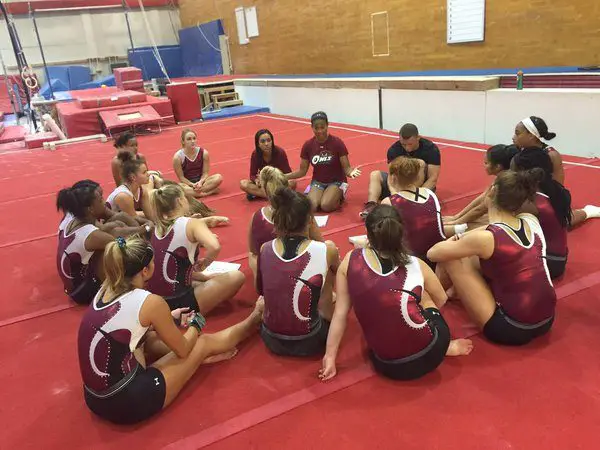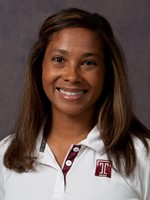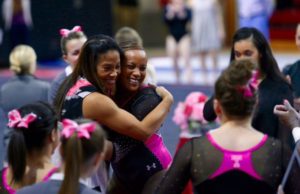Welcome to Interview #61.
I am pleased to share with you the wisdom of NCAA Division 1 Women’s Gymnastics Coach of Temple University, Umme Salim-Beasley.
The advice she provides is incredibly valuable for athletes pursuing their dream of competing in college regardless of sport.
Umme Salim-Beasley (ooo-me) was hired as Temple’s head women’s gymnastics coach in April, 2015. Salim-Beasley had spent the previous four seasons as an assistant coach at Rutgers University, and was named the East Atlantic Gymnastics League (EAGL) Assistant Coach of the Year in 2014.
Coach Salim-Beasley’s full bio is at the end of the interview.
What can or should high school athletes do from their end to get on your radar screen?
Gymnastics is a sport where recruiting is done very early. We begin to make scholarship offers in their sophomore to junior years. In most circumstances this is late for Division 1 programs to make scholarship offers. Many D1 programs are making offers to the best gymnasts in their 8th or 9th grade years.
The best way to get on our radar is to contact us through phone or email to let us know that they are interested. Of course we are not able to initiate a phone call or email, so they will not receive a response until September 1st of their junior year. Contacts are made through coaches.
Phone messages or emails should include graduation year as well as links to YouTube or websites. It is best that their websites stay up to date with videos of practices as well as competition videos. This helps us to see the progress an athlete makes throughout the year.
If a gymnast personally contacts you by phone or email, what will you do next?
If an athlete contacts us by phone they most likely want to know what opportunities are available to them. We are very honest with recruits in letting them know what we are looking for in regards to scholarship requirements and walk-on requirements. We also let them know where they would stand in our recruiting process, if they are someone we would be considering for a scholarship, or if we see them as having walk-on potential.
We give them information about our university and athletic department so that they can get a good feel for what Temple and our athletic department has to offer.
If they contact us through email, it has to have been after September 1st of their junior year for us to respond to the email. If it is, they generally send an introduction letter with links to their website or YouTube page.
They generally continue to keep in contact with us sending general updates of their progress. Once we have finished recruiting a class, we will also let interested gymnasts know that we have completed our recruiting for a particular class and have no more space to add any additional gymnasts.
What effect does social media have on your recruiting? Can you talk about players who you have either stopped recruiting or become more interested in based on their social media use?
We do take social media in to consideration. It is so important that potential student athletes understand that their conduct on social media is a very good representation of their conduct and behavior.
For a coach who is not familiar with an athlete, social media is a good way for us to get a feel for a gymnast. Often times through emails, phone calls, or unofficial visits, athletes tend to be on their best behavior. Their social media accounts tend to be their comfort zone. If a gymnast conducts themselves poorly or in a manner that would reflect badly on our university, we would definitely have second thoughts about pursuing them.
Could you share, in whatever detail you are comfortable, what the athletic scholarship break down looks like on your roster?
Temple is a fully funded Division 1 program. This means that we have the full allotment of scholarships that the NCAA allows for gymnastics. That scholarship count is 12 full scholarships. When you are fully funded, you do not have the ability to break the scholarships up and offer partial scholarships. Any scholarship offered is a full scholarship.
 The scholarship includes room/board, tuition, books/ iPad, fees and cost of attendance. The cost of attendance is something new that the NCAA passed in the last few years which allows schools to give up to $5000 additional to student athletes to cover any additional costs that would relate to them being a student athlete. Not all colleges give the full $5000 in cost of attendance.
The scholarship includes room/board, tuition, books/ iPad, fees and cost of attendance. The cost of attendance is something new that the NCAA passed in the last few years which allows schools to give up to $5000 additional to student athletes to cover any additional costs that would relate to them being a student athlete. Not all colleges give the full $5000 in cost of attendance.
What is the role of the parent in the recruiting process?
Our hopes are that parents are a support system when it comes to recruiting. We are happy to speak with parents about their gymnasts, but we prefer to speak with the gymnast. We like to hear what the gymnast’s thoughts are and what they are looking for in a school.
We do like to see the interaction between the gymnasts and their parents. This is also a good indicator of behavior. If a parent is doing all of the talking in a phone conversation or on a visit, it may lead us to believe that the gymnast is not comfortable or has been in an environment where the parents have done everything for them. This may indicate a difficult transition from high school to college. These are all factors.
After all, we are recruiting the athlete, not the parent. We want to get to know the athlete as much as possible. The recruiting process is an interview which is two sided. One side is the athlete being interviewed and on the other side, it is the potential college coach.
What is the difference between the gymnasts who have a successful college career and those who don’t?
The successful college gymnast does everything they possibly can to better them self as a college athlete.
- They don’t make excuses.
- They give 100% effort in all things, academics and athletics.
- They are team players.
- They look back at their careers and know they gave everything they possibly could.
- They are not always the athletes that win. Receiving awards are great. That is not always the indicator of a successful athlete.
On the other hand there are gymnasts that are not successful.
- They tend to have lots of excuses.
- Their actions don’t match their words.
- They tend to complain about their situations instead of doing what needs to be done to be successful.
- They also like to place blame on other people. Generally the blame is towards the coaching staff, trainers, teammates, or administration. When the only person they need to blame is themselves.
What are some myths or misconceptions about collegiate gymnastics?
Many people believe that college gymnastics is easy. This is primarily because we are limited to the amount of hours we are able to practice in college. Most young gymnasts practice 30-40 hours per week, so  cutting back to 20 hours seems pretty easy. Unfortunately, that is not the truth. The intensity level of college practices is much higher. You have a shorter amount of time to accomplish just as much as you would if you were training more hours.
cutting back to 20 hours seems pretty easy. Unfortunately, that is not the truth. The intensity level of college practices is much higher. You have a shorter amount of time to accomplish just as much as you would if you were training more hours.
College gymnasts have to juggle classes, practices as well as mandatory study hours throughout their day. Not to mention if you are rehabbing in injury, you are also required to get treatment every day. College gymnastics is hard. If someone thinks that it is going to be easy, they are definitely mistaken. You have to be fully committed to be a successful college gymnast.
What is the role of the athletic training staff with your team and athletes? How do trainers interact and benefit your program?
Our athletic trainers are involved in any athletic related activity we do. They are at our practices and travel with us to competition as well. They are our first line of care when it comes to the well-being of our gymnasts.
Before our gymnasts see doctors, they are able to express an issue with our trainers. Any necessary care is taken care of immediately. If additional care is needed, they schedule doctors’ visits immediately.
The trainers meet with us before every practice to inform us of any limitations an athlete may have. We as coaches follow all recommendations of our trainers and we make adjustments to individual workouts accordingly. If anything were to come up medically with an athlete and we are not on campus, we are quickly informed. We are constantly in contact with our trainers for any updates.
What advice do you have for recruits on how to prepare for their freshmen year in a college gymnastics program? What are typical things you wish incoming freshmen realized or knew before they arrived on campus?
The best advice we give to our incoming freshmen is to continue to work out. Often times athletes think that they can take a break the summer before they come to college. This puts them at a huge disadvantage because they are out of shape when they arrive on campus.
Any time that we have to spend getting an athlete in to shape, sets us back as a team. It will take us longer to get prepared for our competitive season because we have to spend so much time getting them back to where they were. Not to mention this leads an athlete to being sore causing them to be in the training room more than they probably would like to be!
Freshmen should understand that transitioning from high school to college is a process that is not going to be easy. Adjusting to a new environment, a new team and new coaches can be difficult. Homesickness sets in fast! Give the transition time. Your coaches and teammates are here to help you. We want you to be a part of our team and we want you to be happy. Having you as a part of our team makes us better. You will get through the difficult time and there are lots of people here to help you on your way.
How is collegiate gymnastics structured? How many programs are there?
College gymnastics is structured in to conferences. You compete against your conference opponents as well as other programs throughout your season. You can have a total of 13 regular season competitions. This includes your conference championship. Post season includes qualifying to your regional championships. The top 36 teams in the country qualify to regionals. At regionals, the top 2 teams out of each 6 regional championships qualify to the national championships. There are 82 colleges that have women’s gymnastics. 62 Division 1 6 Division 2 and 14 Division 3 schools.
I noticed you are in the ECAC (Eastern College Athletic Conference) conference. What is this and how does it differ from the other athletic teams at Temple?
Temple University is in the American Conference. The American Conference does not sponsor gymnastics because there are not enough schools in the conference that have gymnastics. There has to be at least 4 schools that have gymnastics to have a conference championships within the American Conference.
This is why we are in the ECAC conference. The ECAC conference is a very high academic rated conference. All of the Ivy League schools that have gymnastics as well as William and Mary are in our conference. The ECAC conference does not require us to compete against the other schools in our conference during our regular season. We just meet them at the conference championships. This does give us the flexibility to make our competition schedule the way we would like so that we can choose who we would like to compete against.
Bonus Question: Is there anything important that you would like to share directly with high school athletes or gymnasts in particular as they navigate the recruiting process?
I would recommend that they take the time to see schools. Try not to let the reputation and the lure of a “big” name school make your decision. Weigh the factors. Does the school have the major you are interested in? Do you like the campus? Do you like the coaches/ team? Can you imagine spending 4 to 5 years of your life here? What is the most important factor for you and your gymnastics? Would you like to go to a top program where you may not compete or only do 1 event, or would you like to make an impact on a lower ranked school where you can contribute on all events.
Most of all, don’t get discouraged. If you are young and have not received any interest from schools, that is okay. There are always schools that have opportunities for juniors and seniors in high school. If college gymnastics is your goal, work hard for it. Whether it is a D1, D2 or D3 school, you should find an opportunity that fits you perfectly.
LIKE WHAT YOU READ?
Please take a moment to share it on social media, by clicking on the “sharing is caring” buttons below Coach Salim-Beasley’s profile.
Thanks,
Bryan
Profile:
 Umme Salim-Beasley (ooo-me) was hired as Temple’s head women’s gymnastics coach in late April, 2015. Salim-Beasley had spent the previous four seasons as an assistant coach at Rutgers University, and was named the East Atlantic Gymnastics League (EAGL) Assistant Coach of the Year in 2014.
Umme Salim-Beasley (ooo-me) was hired as Temple’s head women’s gymnastics coach in late April, 2015. Salim-Beasley had spent the previous four seasons as an assistant coach at Rutgers University, and was named the East Atlantic Gymnastics League (EAGL) Assistant Coach of the Year in 2014.
In her four years at Rutgers, Salim-Beasley served as the recruiting coordinator for the Scarlet Knights and worked with the uneven bars, among other day-to-day duties for the program.
Salim-Beasley helped Rutgers to a NCAA Regional berth in 2014 and its best EAGL finish in school history. Uneven bars were a big part of the success, as four gymnasts earned all-conference in the event.
In addition, Salim-Beasley guided one of her student-athletes, Alexis Gunzelman, to the top regional qualifying score (RQS) in the conference on bars (9.845) on the way to the first NCAA National all-around appearance by a Scarlet Knight in program history. Gunzelman posted a 9.800 at the national meet, her eighth consecutive meet with at least that score to end the season.
As recruiting coordinator, Salim-Beasley expanded the Scarlet Knights’ base nationally to attract top talent from outside the area. Traditionally recruiting in New Jersey and the surrounding states, the Scarlet Knights were able to pull in gymnasts from Florida, South Carolina, Arizona and Massachusetts.
Salim-Beasley brought impressive credentials to Rutgers, having competed collegiately at West Virginia University from 1995 to 1998. A native of Pasadena, Md., she was a two-time national qualifier at Hill’s Gymnastic Training Center in Gaithersburg, Md., before earning a full scholarship to WVU.
Salim-Beasley was named Atlantic 10 Rookie of the Year as a freshman at West Virginia, and earned spots on the All-EAGL First Team in all-around, bars and beam her sophomore and junior seasons. She finished off her career by being named the EAGL Gymnast of the Year and Most Outstanding Senior Gymnast in her final season in Morgantown in addition to winning the EAGL all-around, bar and beam titles that year. Her accomplishments also ranked her as the fifth-best gymnast in the country and as a finalist for the AAI Award in 1998.
After graduating from West Virginia with a degree in early childhood education, Salim-Beasley went into coaching, starting as an assistant coach at Penn in 1999. During her one season with the Quakers, the team won the Ivy League Championships in addition to an undefeated regular season, breaking team records in every event.
Salim-Beasley returned to Morgantown as a volunteer assistant coach during the 2006-07 season.
For three years, she coached the Severna Park High School gymnastics team to two county championships, including an undefeated regular season in her first year. Additionally, she coached two different gymnasts to all-around championships.
Salim-Beasley was also a teacher at Eagle Cove School in Pasadena, Md., for four years and is working towards a masters in education from West Virginia University. She is married to former WVU football All-American and NFL veteran, Aaron Beasley, and the couple have three daughters: Amirah (12), Dahlia (9) and Layla (6).


